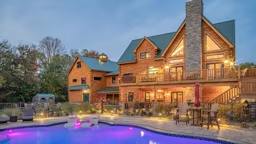
The word “resilient” means “to withstand, adapt and recover,” and we all strive to live up to these terms. So how can we apply the idea of resiliency to log and timber homes? I believe there are two primary areas of focus that will help achieve this goal.
Build to Withstand Natural Disasters
The possibility of hurricanes, tornadoes, wildfires and other calamities is a real concern for the majority of American homeowners. There may be nothing we can do to prevent these disasters, but there are things we can do to enable our homes to bounce back, if catastrophe should strike.
Resilience starts with the materials you choose and how they are constructed on the job site, and logs and timbers have an edge. The typical log or timber house doesn’t simply last 20 or 30 years; if properly built and maintained, they can last for centuries under “normal” conditions. However, thanks to the way the logs and timbers are integrated and fastened, they’re also able to bear harsh weather events — even fires — that other types of homes wouldn’t survive.
Take log homes for instance. There’s a misconception that a full-log home is more susceptible to fire devastation because of all the exposed wood. In reality, the density of the logs can help slow the blaze, whether it’s originating from inside or outside the home.
An example: When the Gatlinburg, Tennessee, wildfires broke out in 2016, I had built several area houses within a short distance of each other: two log cabins and a stick-framed house sided in cement board. The cabins sustained only minor damage — mostly charring — because the logs’ thermal mass prevented the houses from actually catching on fire. The cement-board-sided house, however, burnt from the outside in. It didn’t have thermal mass to stifle the heat and flames. With some repairs, the log cabins were able to be saved. The other house was a total loss.
Fire isn’t the only danger log and timber homes can stare down. Because of their engineering, solid construction and rigid fastening systems, they’re also better equipped to endure the high winds and pounding rains that come with hurricanes or tornadoes. As a builder, I’ve seen numerous instances of log and timber homes that stood strong against severe weather while other types of housing were destroyed. If you’re building in areas prone to these sorts of storms, impact-resistant windows and high-wind-load-rated roofing fortify the house even further.
Create a Reliable Infrastructure
Every home needs electricity, water, waste removal and telecommunications, and keeping these systems operational no matter the circumstances is a key part of a home’s resiliency.
Many log and timber buyers assume they will connect to public utilities, but often, rural areas don’t offer that capability or the main lines are so far away from the building site, they’re quite costly to tap into. So what can you do? Create your own infrastructure.
Power
Historically, people have relied on the grid for electricity, but now more homeowners are turning to alternative energy, like solar or wind, to provide power even if a public utility is available. Why? Once the equipment is installed, you’ll never have an electrical bill again.
Even if you choose the grid, you’d be wise to include an alternate power source as part of your personal infrastructure in case there are issues, like downed power lines; blackouts due to outdated power plants; or interruptions caused by computer hackers (the threat is real). Consider a backup generator to keep essentials, like the furnace and refrigerator, running during an outage. If you don’t have the budget for the generator now, pre-wire your house to accommodate it later on. Retrofitting will be much more expensive than planning for it during construction.
Water
In rural areas, tapping into city water is often impossible or cost prohibitive due to the distance from the site to the water main. The average homeowner spends at least $4,000 in hook-up expenses. Something seemingly as simple as installing the water meter can cost around $2,500 alone. Then there is the possibility of service interruptions, not to mention the monthly water bill from now until the end of time. Digging a well may be in order.
Installing a well typically costs $8,000 to $15,000, but once that infrastructure is in place, the water is free, so it won’t take long before the cost of the well pays for itself. Plus, your water needs will now be totally self-sustainable.
If I can give you one piece of advice about wells: Don’t stop digging when you hit water — go deeper to ensure you’ll have a continuous volume of water. Example: You may hit water at 250 feet and have a flow at a rate of three gallons per minute. That’s a pretty good water supply, but you don’t know how that water table might fluctuate.
I suggest drilling down another 200 feet. It will cost you a little more now, but could save you thousands of dollarsin the future.
Septic
Obviously, waste removal is essential, and in the log and timber home world, this often means installing a septic system. It’s also an area where buyers try to get away with the bare minimum in an effort to save money, but I caution against that. If you install a septic system that’s too small to meet the needs of the home’s frequent occupants (yes, factor guests into the equation, too), you will overwhelm the system, and it will fail. In my market, a septic system costs $6,000 to $10,000, and, yes, it’s big bite out of the building budget. But if you scrimp and it fails, it can cost $5,000 or more to fix it, wasting money instead of saving it.
Telecommunications
This is much easier to tackle in rural areas than it used to be. Many modern households’ communication systems are totally cellular and satellite driven, making landlines, cable TV and hardwired internet connections unnecessary. Even today’s security systems operate wirelessly.
If this is your plan, make sure your devices have a clear, consistent connection. Place your satellite dish in a location that’s not only unobstructed by the tree line but also accessible so that snow buildup, which interrupts signal transference, can be removed. When it comes to cell phone service, the nearest tower may be far away or on the opposite side of a mountain. An inexpensive cell signal booster will help mitigate service disruptions.
Many of the ideas discussed here used to be the stuff of radicals or doomsayers, but now, household autonomy, resiliency and long-term cost savings are not only mainstream, frankly, they’re easier to accomplish. With a well-thought-out plan, your log or timber home will not only be able to adapt with the times, it will provide enjoyment for generations to come.
Dan’s Pro Tips for a More Resilient Home
-
Install solid-core interior doors. They will impede the spread of fire inside your home, giving you more time to escape safely. Plus, they dampen sound, making for a quieter, more tranquil home.
-
Upgrade your roof. Metal roofs don’t catch on fire and stand up to hurricane-force winds better than shingles (either cedar shake or asphalt), but if you prefer shingle-style roofing, make sure you use high-wind-rated materials.
-
Add impact-resistant windows. Not just for houses in tornado- or hurricane-prone areas; if your house is built on a mountainside, it could face strong winds and potential projectiles, like tree limbs, too.
-
Consider low-maintenance decking materials. Composite decking with metal railings have longer lifespans and less maintenance than pressure-treated wood does. Composite costs more upfront, but saves you money and time in the long run.
-
Invest in high-quality stain. Whether you’re building a full-log house or a timber home with only a few exposed wood elements, a quality stain specifically designed for log and timber homes will reduce the impact of long-term weather exposure, making your home more resilient and minimizing the amount of maintenance you need to perform over its life.
See also: The Florida Log Home That Withstood Hurricane Irma
About the Author
Dan Mitchell is a builder and a Log & Timber Home University professor. He owns Eagle CDI, a construction firm based near Knoxville, Tennessee.











